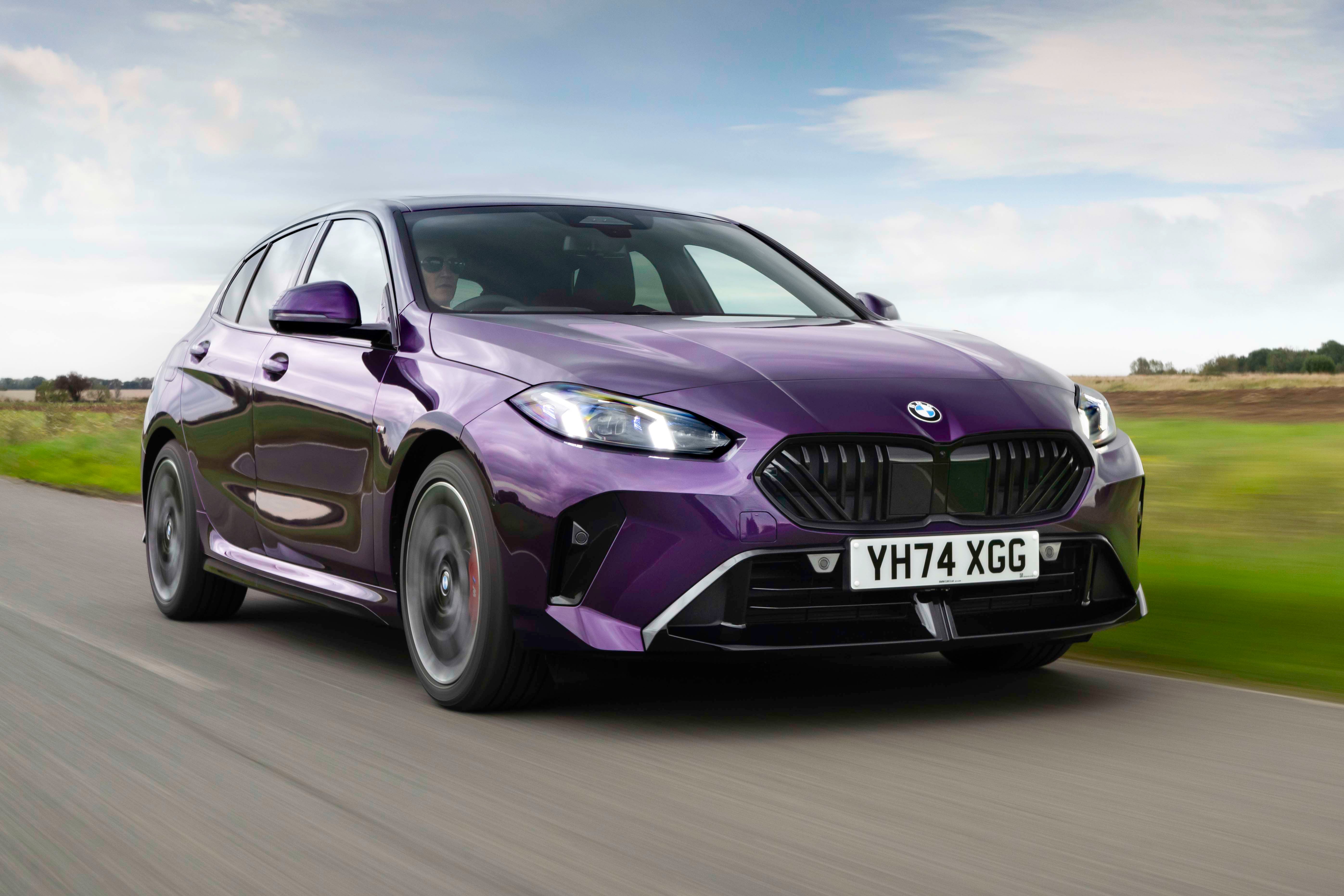BMW 1 Series Review 2025: Price, specs & boot space
Written by Antony Ingram
Quick overview
Pros
- Enjoyable handling and composed ride
- Cabin looks and feels great
- Undercuts rivals on price
Cons
- Over-reliance on the touchscreen
- A little too cosy in the rear
- No low-BIK plug-in version for business users
Verdict: Is the BMW 1 Series a good car?
"The new BMW 1 Series is much like its predecessor in many ways, but meaningfully improved in nearly every area, from the way it drives, to the sharp dashboard design and upgraded technology. It’s no more spacious than before, and with no plug-in model, it’ll be expensive for company users to run. But, prestige-seeking, driving-enthusiast private buyers should love it."
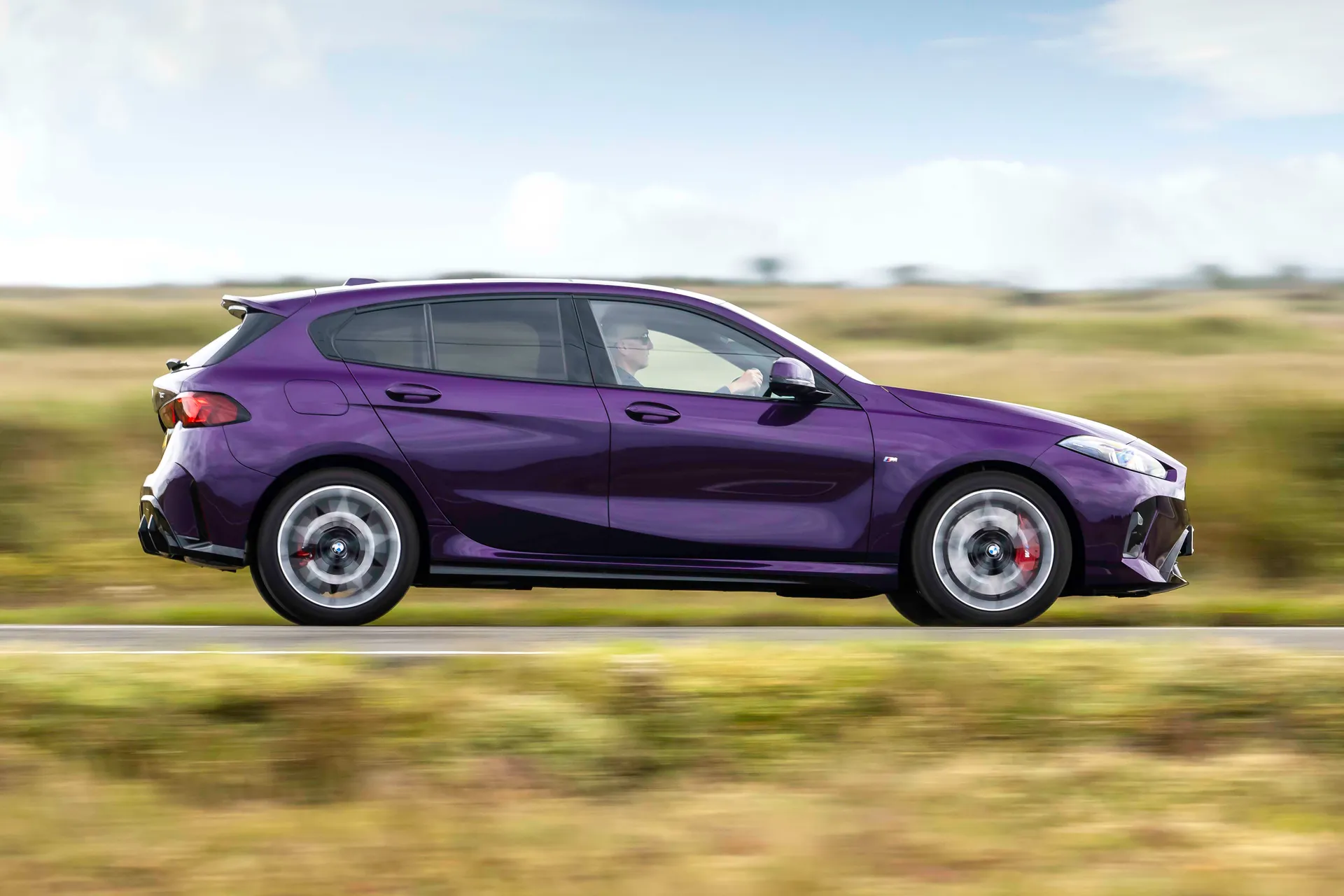
BMW fans grumbled when the third-generation 1 Series arrived in 2019 with front-wheel drive rather than the brand’s traditional rear-wheel-drive layout. The grumbling was fair, given that even BMW itself had been shouting about the benefits of rear-wheel drive in its marketing for decades. However, most buyers neither minded nor cared, and the model is a common sight on UK roads.
For 2024, there’s a new BMW 1 Series, although it’s related to the previous car under the skin, again sharing its platform and engines with larger MINI models. The styling is familiar (and not just to the old 1 Series: does that front end look a bit like the Kia Ceed to anyone else?) but BMW has made improvements to the car’s chassis, powertrains, and to the technology on offer, helping to keep it competitive with other premium hatchbacks like the Audi A3 and Mercedes-Benz A-Class.
And competitive it undoubtedly is. Punchy pricing means the BMW 1 Series undercuts the equivalent Audi and Merc version-for-version, while the cabin design and quality are among the best in this class. The in-car tech is effective, too, despite a slight over-reliance on the touchscreen for some functions, and the BMW 1 Series is one of the best cars in this class to drive, with a fun and engaging feel irrespective of which wheels are being powered.
The only real areas in which the new BMW 1 Series lags behind are in outright passenger space, and the fact that while the engines offered perform well and don’t use much fuel, there’s no plug-in hybrid model, which means no low-BIK variant to tempt business users. Private buyers shouldn’t mind too much at all, though, as they’ll have one of the best premium hatchbacks on sale.
Looking for a used car for sale? We've got 100s of BMW Approved Used Cars for Sale for you to choose from, including a wide range of BMW 1 Series models for sale. If you're looking for the older version, you need our BMW 1 Series (2019-2023) review.
Is the BMW 1 Series right for you?
The BMW 1 Series is a cut above other family hatchbacks, residing in the same premium class as its Audi A3 and Mercedes-Benz A-Class rivals. If you’re looking for badge appeal without the costs of stepping up to one of BMW’s more prestigious saloons or SUVs, then the BMW 1 Series is there to serve that purpose. BMW sees it as a stepping stone into the brand, while buyers will see it as the most affordable way of putting a new BMW on their driveway.
And while a five-door, front-wheel-drive hatchback isn’t exactly BMW’s bread and butter, don’t think you’re getting a less well engineered car at this entry level. The BMW 1 Series isn’t quite as practical as some rivals, but if driving fun is a priority, then not many current hatchbacks do it better.
What’s the best BMW 1 Series model/engine to choose?
With not many engines to choose from with the BMW 1 Series, the question of which is better comes down to your needs as a driver: and of course, your budget. The sporty BMW 1 Series M135 xDrive is £10,000 more expensive than the BMW 1 Series 120 in M Sport form, for example, which may immediately rule it out for some, and with lots more power, naturally it uses more fuel, too.
Perhaps the real deciding factor is that there are better hot hatchbacks on the market than the M135, but as far as premium family cars go, the BMW 1 Series 120 is much further towards the top of its class. This makes the 120 the pick of the range for us, being swift and frugal and not notably more expensive than the equivalent Volkswagen Golf. Splash out on M Sport trim, and you get most of the M135’s look and feel, too. That said, you may consider the xDrive 123 to be a desirable halfway house.
What other cars are similar to the BMW 1 Series?
Take your pick from the current crop of five-door family hatchbacks, although in ethos, the BMW 1 Series is closest to the Audi A3 and Mercedes-Benz A-Class, the premium hatches from BMW’s closest rivals. You could throw the Volkswagen Golf into the mix, too, while casting a wider net includes cars such as the Cupra Leon, Peugeot 308, Vauxhall Astra, Mazda 3 and Honda Civic. The latter pair may be be lacking a premium badge, but they certainly feel like a premium car for interior quality and the way they drive.
The BMW 1 Series’ latest iteration, though, has moved it on a few notches from its predecessor, and in 120 form at least, is among the better cars in this class to drive: surely priority number one for BMW. It’s a little cramped in the rear seats next to some of the larger models in the class, but the interior look and feel is among the best, too.
Comfort and design: BMW 1 Series interior
"For quality and design, the new BMW 1 Series’ cabin is at the top of its class. It’s modern without being austere, the materials feel great, and the driving position is excellent, too. Only a little too much reliance on the (admittedly very usable) touchscreen lets the side down."
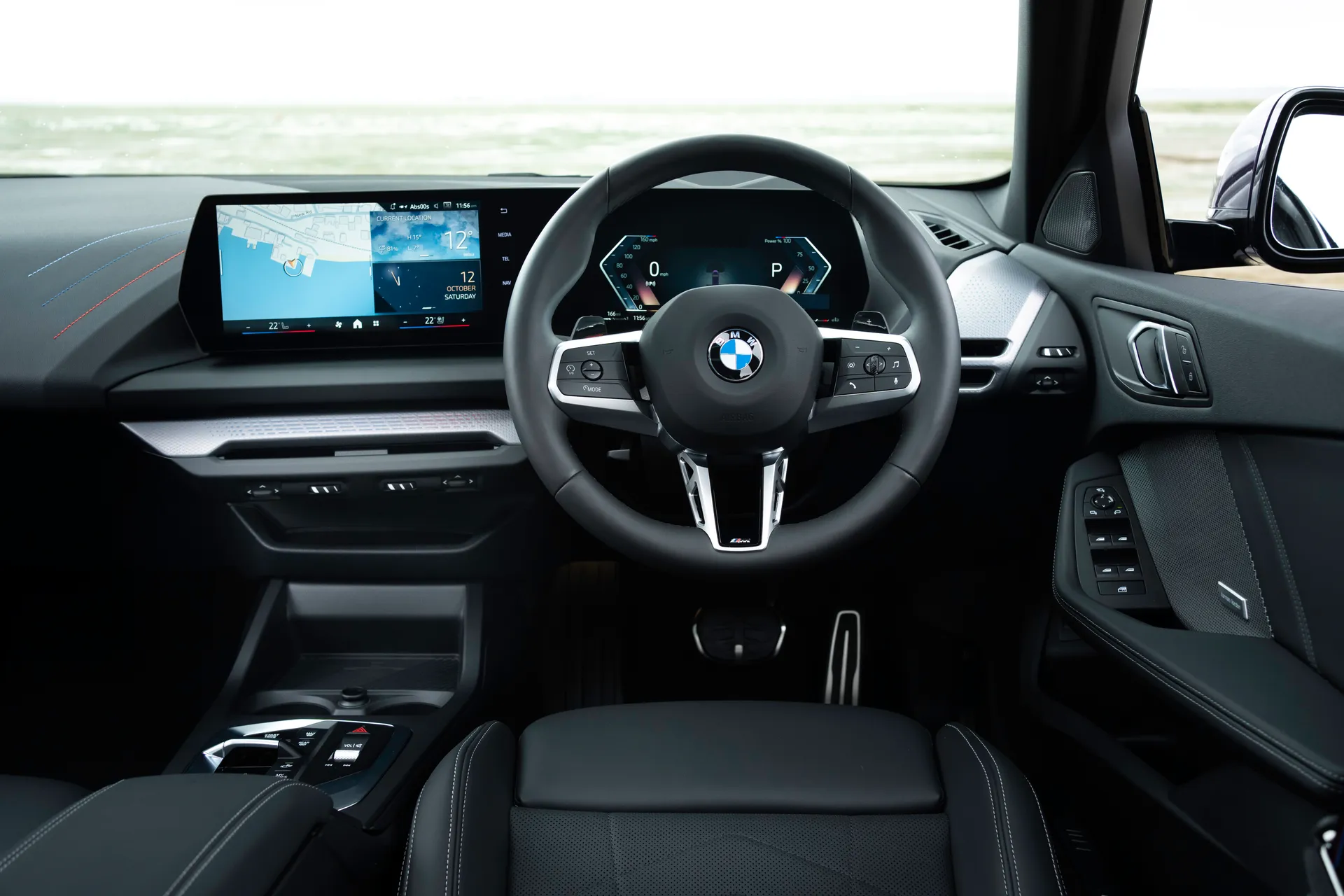
The outgoing BMW 1 Series had a smart interior layout, but didn’t quite have the wow-factor of a Mercedes-Benz A-Class. The latest 1 Series bridges that gap design-wise, feeling modern and minimalist without changing the fundamentally good layout of the old car. There’s the by-now-obligatory curved driver information and infotainment display, some striking trim materials and shapes, a sporty three-spoke steering wheel, and that’s pretty much your lot.
BMW has simplified the centre console of the latest car, so it loses the pistol-grip gear selector in favour of a small switch, and the rotary iDrive controller also disappears, with a few hot keys in its place (we’ll get onto its usability further down). Our BMW 1 Series 120 M Sport and M135 test cars both featured an M-stitched artificial leather covering on the dashboard - there’s no woven fabric here like on the new BMW X3 - and all the bits that look like aluminium feel like it too, being cool and satin-smooth to the touch.
The driving position is absolutely spot-on; sitting in the BMW 1 Series just feels right, and the seats are well-shaped for both support and comfort. The rear seats are comfortable, too, but with space back there restricted for taller passengers, not everyone will be able to appreciate them.
Quality and finish
Like other recent BMWs, the 1 Series feels great inside. Almost everything that looks like leather is actually man-made (M Sport steering wheel trim aside), but you’d not know it from the soft, quality feel. The aforementioned aluminium-look trim feels like the real thing, there’s a pleasing lack of fingerprint-attracting piano-black plastic. Even the regular old textured black plastics have a soft-touch feel, but don’t yield or creak when you pry further.
The quality feel continues on the road, where we didn’t detect any rattles or groans, and everything you interact with – steering wheel, gear selector, pedals, gearshift paddles, minor switches – has a well-oiled action. Simply, the 1 Series feels like one of the best-built cars in its class.
Infotainment: Touchscreen, USB, nav and stereo in the BMW 1 Series
The 1 Series’ curved screen isn’t quite as expansive as it is in some larger BMWs, but it gets BMW’s Operating System 9 software, and has all the features you’d expect. Apple CarPlay and Android Auto are standard, you can use your phone as a digital key, there are numerous downloadable apps and connected features, and it’s capable of over-the-air software updates.
For clarity and response, the screen is pretty good, and while with any touchscreen, you do need to take your eyes off the road for most functions (and there’s no longer a physical iDrive wheel controller as an alternative), the BMW 1 Series’ relatively cosy cabin means everything on the screen is within easy finger reach. You do get a handful of physical controls, too, with audio and track-skip functions on both the steering wheel, and on the centre console.
It’s a shame most of the heating and ventilation functions are now touchscreen-only, and the latest shortcut key for turning off certain driving assistance functions is no longer as intuitive or quick as the single button in the old car: it’s now a combination of a button press on the centre console, then individually selecting features on the touchscreen to turn off. Changing driving modes is clunky, too, with another console button press, then a touchscreen press: and you then have to prod the touchscreen again to make the drive mode menu go away.
Space and practicality: BMW 1 Series boot space
Space is one of the latest BMW 1 Series’ weaker areas. Not for front-seat passengers, who get the wide range of seat adjustment (and for the driver, steering wheel adjustment) we’ve come to expect from a BMW. But considering the 1 Series went front-wheel drive a generation ago partly to benefit cabin space, it’s a little surprising that the rear quarters still feel so cosy.
A six-foot passenger will just about be able to sit behind a driver of the same size, but there won't be any room to spare, and if either party is any taller than that, then you'll really start to struggle for both headroom and legroom. A shortage of natural light means it’s a little gloomy back there, too. The door pockets are slightly obstructed by the armrests both in the front and rear, but up front, there are a couple of cupholders and some sensible phone-shaped cubbies for both driver and passenger.
BMW gives a headline figure of 380 litres for boot space, which on the face of it, looks competitive: it's 10 litres more volume than you get in a Mercedes A-Class, it's identical to an Audi A3, and just one litre shy of a Volkswagen Golf. However, that figure includes the space you get underneath the liftable boot floor, and that space differs according to the version of the 2 Series you pick. On the M135, there's a huge underfloor space that gives you the full 380-litre capacity. However, in cars fitted with mild hybrid tech - which includes both the 120 petrol and the 123 petrol - half that space is taken up by batteries. That brings the total volume down to 300 litres, which all of a sudden, doesn't look nearly so competitive. What's more, some rivals from non-premium marques give more space still, cars like the Honda Civic (410 litres) or Skoda Octavia (a full 600 litres).
Still, the versatile 40:20:40 rear seats flip down for up to 1,200 litres of loadspace (1,135 litres in the mild hybrids) when you need to carry more, though the backrests lie at an angle, leaving a slope in your extended load area.
Handling and ride quality: What is the BMW 1 Series like to drive?
"No, you won’t get the rear-wheel drive handling of the BMW 1 Series from a few generations back, but as front-drive hatchbacks go, the 1 Series feels pretty good, with a taut feel, keen responses, and a firm but expertly controlled feel to its ride. Responsive engines complete the dynamic package."
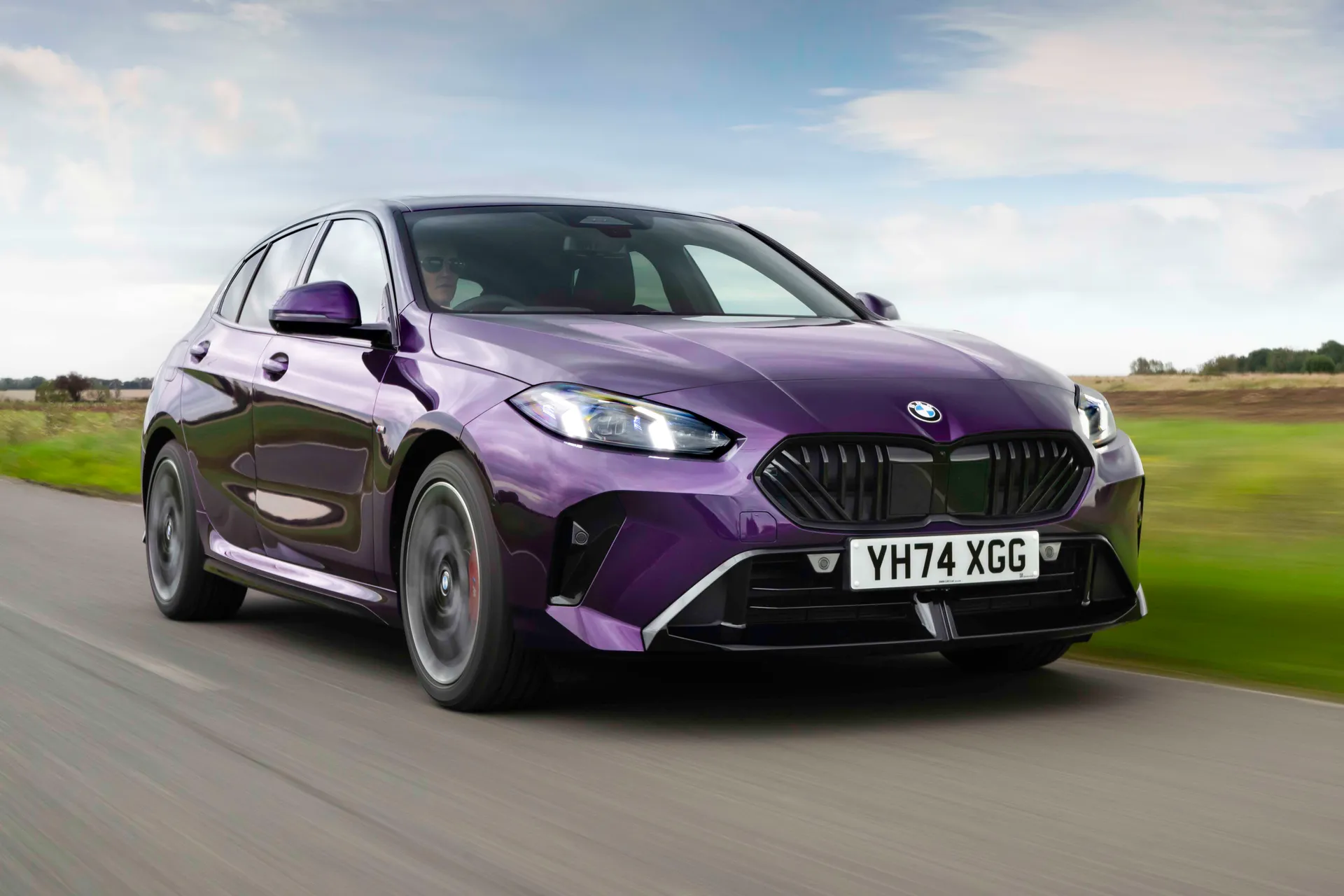
The nature of the suspension you get on your 1 Series will differ according to which version you pick, so you might have to pick carefully for best effect. The entry-level Sport car has a regular passive suspension as standard, which we haven’t had the opportunity to try yet. That’s because all the cars we’ve had access to so far have been in the more popular M Sport trim (70% of buyers choose this version), and this gets something called M Adaptive Suspension as standard.
Now, it’s important to note here that this isn’t the same as the adaptive suspension that’s available on BMW’s bigger models, which allows you to firm up or soften off the suspension dampers electronically by changing driving modes. Instead, the 1 Series’ version has less sophisticated twin-chamber dampers, which can adapt their behaviour only very slightly in reaction to the nature of the road surface beneath them. This means that there’s no variation in the behaviour of the suspension according to whether you select the car’s sporty driving mode, or a more relaxed one.
That doesn’t mean, however, that the 1 Series M Sport is a disappointing car to drive: far from it. Okay, so the BMW purists are probably still livid to this day that the firm had the temerity to switch the car from being rear-wheel drive to front-wheel drive from the previous generation of the 1 Series, but everyone else simply doesn’t care and, in all likelihood, probably wouldn’t even notice. This is still a very enjoyable car to drive, with really sharp responses, tight body control, strong grip and good balance.
Yes, the ride is a little on the firm side, so if you want ultimate comfort, you might be better served by one of the Beemer’s rivals. Importantly, though, it still does a very decent job of smothering most lumps and bumps, so it’s far from uncomfortable, and the firmness is well worth putting up with for the agility it gives. And while the car’s Sport mode has no effect on the suspension, it’s still worth selecting, because it turns the steering from feeling too light and slightly artificial, into feeling weighty and satisfying.
Choose the M135, and you’ll get a similar adaptive setup, but while the M Sport’s suspension sits 8mm lower than that of the regular 1 Series, the M135 is actually only 5mm lower: the difference is to help accommodate the M135’s bigger quad exhaust system. In terms of ride and handling, however, it feels pretty identical to the regular M Sport: the main difference you might detect is the extra traction you get from the M135's standard xDrive four-wheel drive system. The M135 does have a sportier character, though, due to its more powerful and better sounding engine. For buyers who fancy an even sportier character, there’s the option of adding something called the M Dynamic Package. This gives you revised suspension hardware such as specifically tuned dampers, stiffer piston rods and stiffer stabiliser brackets, while you also get lightweight wheels, increased body bracing, and upgraded brakes taken from the BMW M3/M4. We haven’t yet tried a car fitted with this option, though, so we can’t comment on how effective it is.
What engines and gearboxes are available in the BMW 1 Series?
Initially, buyers got a choice of either a 1.5-litre turbocharged three-cylinder petrol, badged 120, or a 2.0-litre turbocharged petrol hot hatch with all-wheel drive, in the form of the M135 xDrive. Note BMW’s naming convention these days too: no more ‘i’ on the end of the variant number.
Both get a seven-speed dual-clutch automatic gearbox as standard, and of course in non-xDrive form, the BMW 1 Series remains resolutely front-wheel drive: the platform underneath is essentially similar to that of the larger modern MINIs. The 120 makes a punchy 170PS while the M135 develops a nice round 300PS, and the pair have 0-62mph times of 7.8 seconds and 4.9 seconds, respectively.
You’d expect the M135 to be fun, and it is, with that augmented four-cylinder growl we’ve become accustomed to in modern hot hatches, swift changes from the dual-clutch ‘box, and keen throttle response, plus plenty of traction.
As with the ride and handling, though, the surprise is the 120, which has a characterful three-cylinder sound and plenty of urge from the bottom of the rev range, and in Dynamic mode, there’s snappy throttle response and a touch more volume, too. It works really well with the automatic gearbox, too, with the shifts staying smooth and unobtrusive at all times.
A wee while after the 1 Series was initially launched, BMW extended the range to include the 123 xDrive in between the two bookend engines., This has a 2.0-litre engine giving 218PS, with 0-62mph coming and going in 6.2 seconds. We haven't yet had the chance to try it, though.
Refinement and noise levels
As well as being a bit of a hoot, the three-cylinder BMW 1 Series 120 is impressively refined. too. You can hear the offbeat note, but you really can’t feel it: there’s no sense of those three pistons thumping up and down at idle like you get in a lot of cars with a similar configuration. On a cruise, even a faster Autobahn run, it still remains impressively quiet, but select Dynamic mode, and you get to enjoy the burbly engine note whenever you like.
The M135’s four-cylinder and obviously sportier focus mean the engine is more ever-present, but it too disappears mostly into the background when you’re just ambling around. As well as benefiting the car’s ride quality, the stiff structure also helps with refinement, as road noise is fairly well isolated. Wind noise is minimal, too.
Safety equipment: How safe is the BMW 1 Series?
Safety body Euro NCAP hasn’t yet sent the new BMW 1 Series to its doom in crash testing, but with the outgoing model achieving a full five-star rating in 2019, we’d expect more of the same when the latest car meets a deformable barrier. The tweaks BMW has made to the body structure should contribute to its performance in crashes, and the brand has kept pace with developments in crash mitigation and driver assistance functions, so the latest car comes as standard with Driving Assistant with front collision warning, Lane Departure Warning, Exit Warning and Traffic Sign Recognition, among other features. It's a bit rubbish, though, that adaptive cruise control isn't provided as standard, and you have to pay extra for it.
The process for disabling some of the assistance features is a little more long-winded than the old model’s single button press and hold. Now you need to press the relevant button on the console near the gear selector to bring up a touchscreen menu, and then disable each function (such as lane departure warning and the speed limit bing-bong sounds) individually.
MPG and fuel costs: What does a BMW 1 Series cost to run?
"Business users will be disappointed by the lack of a plug-in hybrid, since BIK rates on the petrols are quite high. But the two engines are pretty frugal in their own right, especially the three-cylinder 120, and the 120’s VED costs aren't too high either."
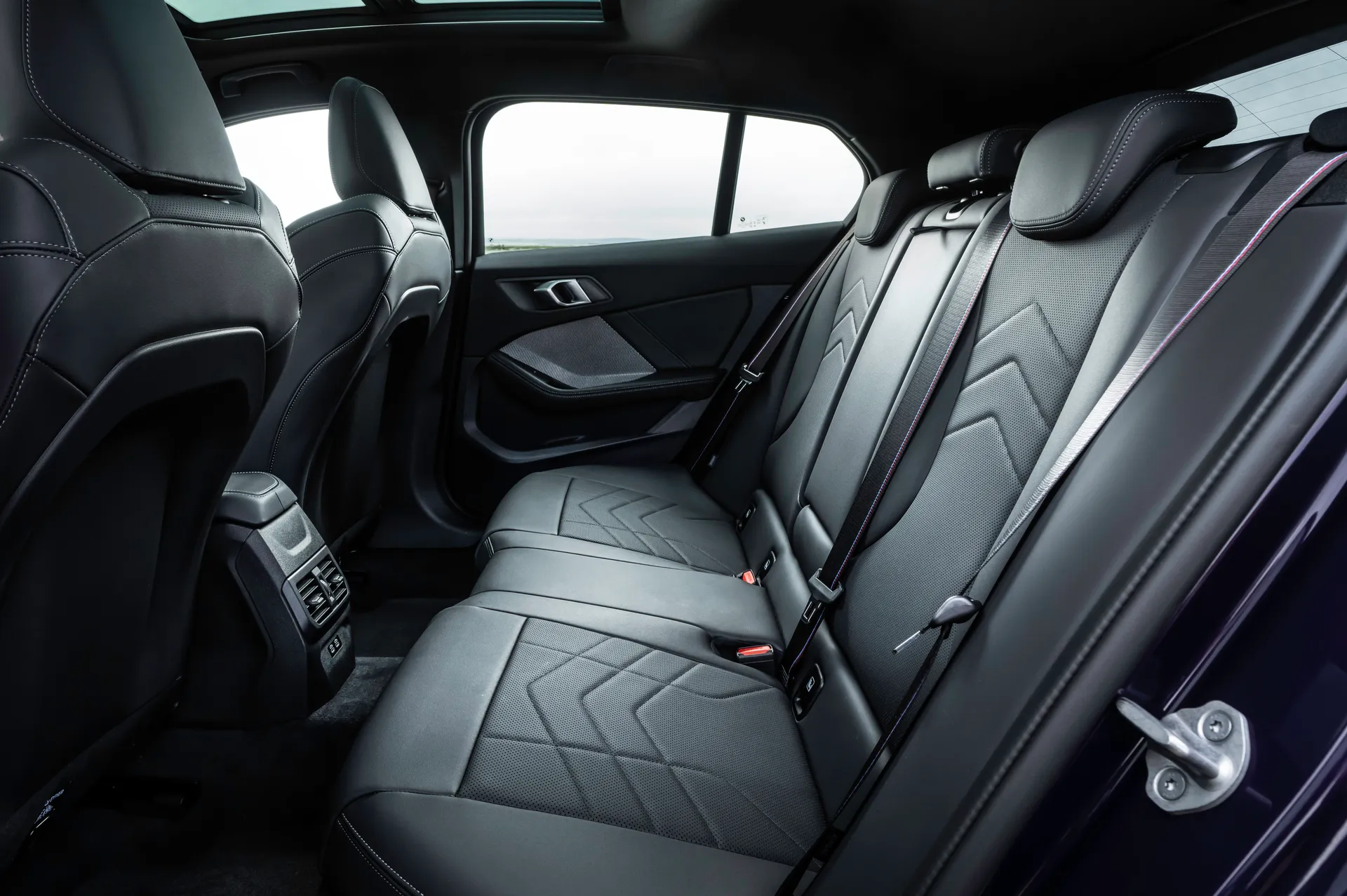
In 120 form, BMW reckons you’ll get up to 53.2mpg in mixed driving. At the end of one of our drives through the German countryside, which included a few minutes on the Autobahn at three-figure speeds, some crawling through villages, and some enthusiastic driving on twisty roads, the trip computer showed an average of 45.6mpg. That’s really not bad at all, we reckon: a more concerted effort to be frugal would surely get close to the official figures.
The M135 meanwhile has a claimed economy figure of 37.1mpg, against which we managed 34.4mpg: again, not a million miles away, although in this case, a driver enjoying the car’s performance to the full might expect less than that in daily use. Official figures foe the 123 suggest that it'll return an average of up to 47.9mpg.
BMW 1 Series reliability and warranty
The most recent HonestJohn.co.uk Satisfaction Index put BMW at 16th place out of 33 brands for reliability, conveniently beating both Audi and Mercedes-Benz, though lagging behind Porsche, and further still behind Lexus and Tesla at the top of the table.
We've seen very little data on the 1 Series itself, but we haven't heard any horror stories, either. BMW's warranty is a little underwhelming, mind, with just three years of cover provided. At least there's no mileage limit.
BMW 1 Series insurance groups and costs
The cheapest BMW 1 Series to insure, predictably, is the 120, which sits in group 21 regardless of trim level (of 50, 50 being the most expensive to insure). The 123 sits a bit higher in group 26, and the M135 a little higher still in group 29.
VED car tax: What is the annual road tax on a BMW 1 Series?
You pay the same flat rate of VED on the BMW 1 Series that you do on all cars built since 2017, and that flat rate is currently charged at £195 per year. However, cars that cost more than £40,000 when brand new also get stung by the luxury car surcharge, which adds an additional £425 sum to your annual bill for a five-year period between years two and six of the car's life, after which you default back to just the flat rate. Currently, it's only the 135 model that has a price that busts this threshold, but the 123 hovers pretty close, and adding some options could take your car over. And if you buy a used 1 Series with which the original owner got a little too tick-happy when faced with the options list, then you'll inherit the same liability. In any case, it's always a good idea to Google the reg of any prospective purchase to find out what you're facing.
In terms of Benefit-in-Kind or BIK tax for company users, for the 2024/2025 tax year the 120 is in the 29% bracket, and the M135 in the top 37% bracket. This is where the 1 Series’ limited engine range hurts it a little, as several rivals offer plug-in hybrid variants with significantly lower BIK rates.
BMW 1 Series price
"BMW’ charges you a little over £32,000 for the entry-level 120 Sport, or £2,000 more for the M Sport. The 123 will cost you around £37,500, while the M135 tops the range at around £45,000. Throughout the range, you can add plenty more cost with optional extras.."
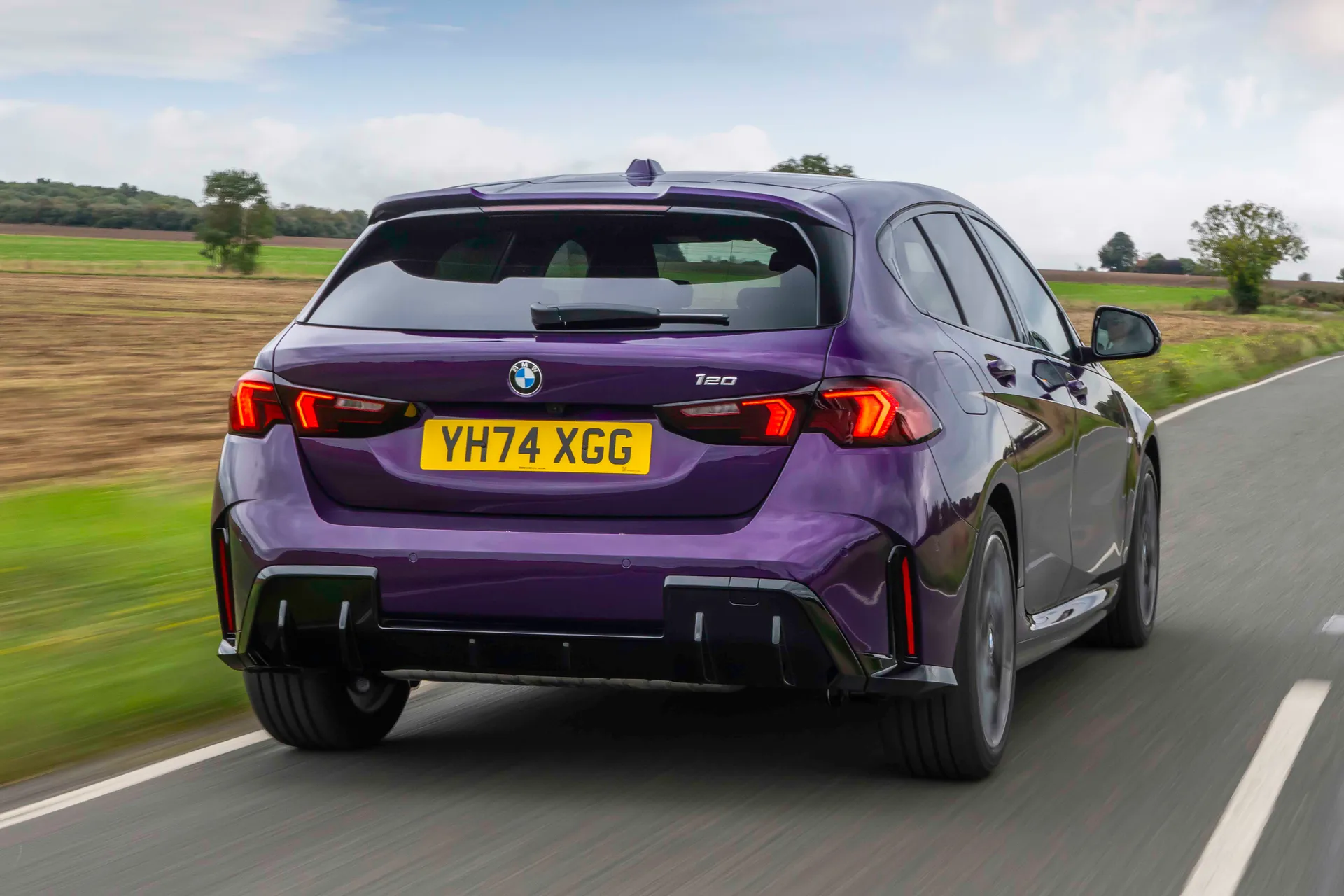
You can save a useful slice by buying used, though. Check out our used car classifieds, and you'll find facelifted examples of the 120 from 2024 with about 4,000 miles on the clock for around £27,000. M Sports can be had for similar money, but these cars a few more miles.
For something a little punchier, year-old examples of the 123 can be had for around £32,000, while a facelifted 135 will set you back from around £35,000.
Trim levels and standard equipment
All BMW 1 Series are well equipped, starting with the 120 Sport, which comes with 17-inch alloy wheels, LED headlights, shadowline exterior trim, ambient lighting, fabric upholstery, heated front seats, a sports steering wheel, air conditioning, ambient lighting, a rear-view camera, a 10.7-inch infotainment display and 10.25-inch instrument display, and standard Apple CarPlay and Android Auto.
Stepping up to the BMW 1 Series 120 M Sport gives you 18-inch alloys, M Sport exterior styling, Alcantara and Veganza upholstery, sports front seats, illuminated interior trim elements, an M Sport leather steering wheel, M adaptive suspension, and all the equipment already found on the Sport. The M135 gets a horizontal slatted grille, a quad exhaust system, rear spoiler, and M Sport brakes with blue calipers on top of the M Sport’s kit list.
BMW then offers Technology-, Technology Plus-, and M Sport Pro packs on top of all that (the latter most notably adding M compound brakes, with pads from the M3), and individual options like dual-zone air conditioning, a heated steering wheel, M Sport seats, and Harman Kardon audio.
Ask the heycar experts: common questions
How much does the BMW 1 Series cost?
What’s the best BMW 1 Series model to choose?
Is there a diesel engine available on the new BMW 1 Series?
Get our latest advice, news and offers
Keep me updated by email with the latest advice, news and offers from heycar.
By submitting you agree to our privacy policy
